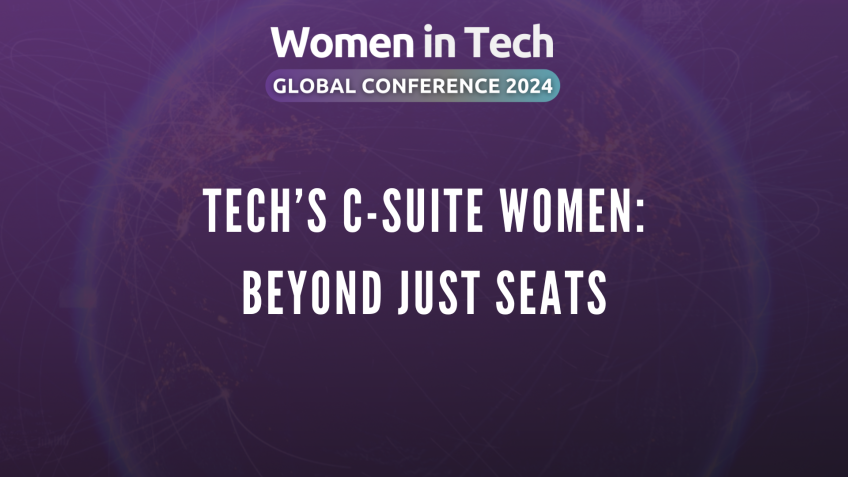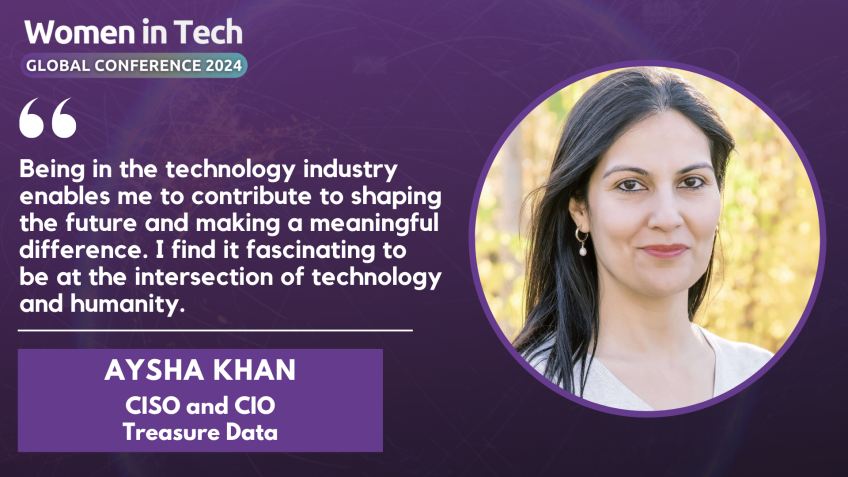Leading boldly and authentically to drive an inclusive culture by Ebele Kemery
Leading Boldly and Authentically to Drive an Inclusive Culture with Margo Miller and Emily Cry
Margo Miller, host of the Women Tech Global Conference, recently welcomed Emily Cry, Head of Global Technology, Diversity, Equity and Inclusion for JP Morgan Chase. In this compelling discussion, Emily shared her insights and experiences on aligning technology with diversity, equity and inclusion, to enhance employee engagement, client service, and community support.
Emily Cry: An Authentic Leader Driving Inclusive Culture
Emily Cry has made remarkable contributions in the world of technology and diversity. With the tremendous responsibility of delivering a firm-wide diversity agenda to over 50,000 technologists, she focuses on inclusivity, supplier diversity, emerging tech and ethical code. Acknowledged with awards like the '2021 Be Stem Winner for Modern Day Technology Leader', and 20th Banking Technology's 'Woman in Tech', Emily's journey personifies the power and need for authentic leadership and inclusivity.
Attributes of Authentic Leadership
Emily emphasises on five attributes that authentic leadership revolves around:
- Purpose: Authentic leaders are led by a strong sense of purpose and a collective mission, that goes beyond professional roles and resonates with the team on a personal level.
- Integrity: Authentic leaders demonstrate ethical values and set benchmarks for fair conduct and dealings.
- Empathy: They understand the feelings and perspectives of others, meeting them where they are. They prioritize the person over output.
- Transparency: Authentic leaders maintain transparency in their communications, eliminating any room for suspicion and fostering trust.
- Consistency: They persistently maintain unity in their words and actions, reinforcing trust within the team.
Building an Inclusive Culture
Emily shares that an inclusive culture accepts, embraces, and leverages our differences, encouraging everyone to feel valued, heard and involved. Such an environment is a breeding ground for creativity and innovation.
Being a Bold and Authentic Leader: Key Recommendations
For those striving to enact authentic leadership within their teams, Emily presents three crucial steps:
- Confidence: Trust in yourself, your decisions, and learning from the mistakes along the way.
- Work on Organizational Culture: Leaders have the responsibility to cultivate a culture that supports authenticity and transformational interactions.
- Embody the attributes of authentic leadership: Live and lead by purpose, integrity, empathy, transparency and consistency to create an impact.
Authentic leadership is rooted in trust and enveloped in meaningful relationships. In a post-pandemic world marred with uncertainties, the transparent leadership of an authentic leader provides much needed comfort and direction in the workplace. They lead with conviction, inspire others and have the courage to act on what they believe in. With these insights and tips from Emily, budding leaders can learn to lead authentically and create more inclusive cultures, driving both personal and professional growth.
Video Transcription
No, the the main stage at the Women Tech Global Conference. My name is Margo Miller.I am from Topel and Start Canada Podcast and I am your host for the main stage for the rest of today in the American time zone that many of you are are looking at now or it might just be very, very late for wherever you are in the world. And we're so happy that you're choosing, join us here today. Um So we have a great lineup of speakers for you on the main stage today. There are still session speakers, you can check out today. There is still a networking area where you can one on one connect. And of course, the Expo area too, if there are certain organizations that you wanna check out. So lots going on. Still right away here to the main stage. We are going to bring you Emily Cry. She is the head of global technology, diversity, equity and inclusion for JP Morgan Chase where she's embedding a diversity lens into how the firm develops technology, how they serve their clients and help the community and how they support their employees. So, Emily, welcome to the stage.
Thank you. Thank you so much. This is quite an honor. I'm really excited to be here.
Well, we are honored to have you here. So let me tell everyone a little bit more about you and then I'll hand it over your way. So right now with your role as head of global technology diversity, equity and inclusion with JP Morgan Chase, you deliver a firm wide diversity agenda to over 50,000 technologists. That's a lot of people focusing on priorities such as inclusivity, supplier, diversity, emerging tech and ethical code, which I think a lot of people who are really interested in various pieces of that. And it sounds like Emily, your lens is really from, from soup to nuts as they say across the teams. Um Emily's governance is an oversight of all DD I programs and pillars across 21 global technology centers. Prior to this role, she held the role of global head of business technology optimization. And before that head of energy investing and is even a multi award winner from the 2021 be stem winner for modern day technology leader to the 20th banking technology awards woman in tech and honored in Crane's New York Business, 2019 notable women in tech list.
And she is here with us today and we are so excited to hear from you about leading boldly and authentically to drive an inclusive culture. So with that over to you.
Thank you. I'm really excited as I said to have this conversation. But I'd love to start with a story just to kind of set the stage for you in the summer of 2006. I was uh completing my second consecutive summer internship at Lehman Brothers. One evening, I completed a bunch of my fellow interns to an event at another bank. The keynote speaker was the CEO. And when he spoke, I just remember myself casually glancing at my blackberry to see if I was going to get someone back into the office. But somehow three minutes in, I stopped, I had been captivated about something the co either said or just something about him. His words were humble. His body language was genuine. And when he spoke, he wasn't, he didn't speak about being the biggest or the best. Um But instead, he's talked about staying true to the mission of being the best financial service company in the world. He spoke about teamwork and about putting the client first. And I believed him fast forward. Three weeks later, I accepted an offer from that institution and told Lehman Brothers that I would be declining their job offer to join them full time. When I mentioned the company, I was going to the recruiter laughed and said, you know, we Lehman Brothers, right? The leader who spoke that night was Jimmie Dimond and the institution was JP Morgan Chase. Now I tell this story because it was only when I became a leader myself, that I fully appreciated.
What happened to me that day, 16 years ago, I met a bold authentic leader as introduced, my name is Abela Camry and I have the great fortune of leading diversity, equity and inclusion for JP Morgan's technology organization. And I am even more excited and proud that I'm here with you today to talk about something extremely important and that's about leading boldly and authentically, particularly to drive an inclusive culture. Let's start with the first five attributes of authentic leadership. Number one is purpose and by that, I mean, leading with heart, what is your, why people want to relate and connect and it is true today more than ever before. People want a job, whether there's meaning they want to know that they're doing something that really matters and teams crave mission and they want to know they're doing something together that is meaningful. So be sure to communicate and share what your purpose is and use that purpose to unite your team. Number two, integrity, we all know that the leader sets the tone and so we need to think about behaving in a way that is in line with our ethical values. Three empathy. This is understanding the feeling of others and being able to meet them, right? Where they are being a leader is not about being in charge, but instead it's about us taking care of those who are in our charge.
It is about being concerned about the person and not the output. My first job out of college was on a commodity trading desk. And three years in, I had earned my own trading book, but I definitely remember my very first substantial trading loss. I recall an oil pipeline burst overnight and it led to the dislocation of oil prices. That morning. I woke up, I looked at my blackberry, I real I did a quick mental calculation and realized that I was way below my maximum drawdown for the year. The prudent thing was to liquidate those positions. So I walked into the office and throughout the entire day, I kept looking for opportunities to unwind that position. I end up realizing the loss of the book. I kept telling myself it was the prudent thing to do. At the end of the day, I was down seven digits. But luckily I was still above my drawdown with my head hung low. I walked over to the head of the trading desk and I notified him of our losses. He remained seated and listened when I was done, he asked me how I was doing and he asked what I had done with the trades and my current positioning. Then something really strange happened. He reached out and he lifted my chin and he said chin up, kid head up and go out there and fight another day. That evening, he sent me the most uplifting email of my career.
I went on to end the year positive, actually beating my PNL target for that year. I credit my own resiliency to that a defining moment. I was shown empathy number four, transparency. This is the combination of honesty, vulnerability and keeping grim. This includes how you show up and how you share information transparency is a key attribute that eliminates suspicion. Let's just talk about suspicion for a second. Suspicion, erodes trust and it can take us years to build for us but only a little suspicion, not proof will destroy it.
And the fifth attribute I find this to be very, very important is consistency. Consistency reinforces trust in who you are and how you show up. So now that we're armed with those five attributes, let's explore inclusive cultures. An inclusive culture is one that accepts embraces and harnesses our differences. Notice I didn't mention representation or diversity. It is simply the recognition and celebration of our differences. We look different, we think differently and we even perceive the world in different ways.
But at the core of our being, we seek the same things, we seek acceptance, belonging and community. I remember the society of women engineers meet up that I attended a couple of years ago. It was a group of female technologists grabbing drinks at mcsorley's which by the way, it's the oldest Irish bar in New York City. There was no agenda. We were just meeting to grab the drinks and talk but there was a moment that evening that it dawned on me that I didn't once once talk about work life balance, having it all executive presence or leaning in. Instead, we traded recommendations about the best tools we griped about execution times and debated the future of all the data. I really felt like I belonged. I had found my tribe. I was amongst technologists who are my peers and I felt incredibly powerful for those of us in the in the in the technology industry. This is particularly important because an inclusive culture allows us to have employees that feel comfortable expressing the ideas, their opinions.
And let's be honest when we are, we are appreciated for who we are. We are likely to share our ideas and willing to contribute to conversations. Even thinking once about how we're being perceived in that type of environment is where creativity and innovation flourish in our post pandemic world. We are in greater need of certainty and truth. The world has changed in the proliferation of misrepresentation, half truths, deep fakes bots.
Many of us are seeking comfort and refuge in terms of transparency that I talk about an authentic leader can provide this solace that is very much needed in the workplace. When we think about this in a nutshell, bold and authentic leaders are self aware, they're empathic and they lead from their he their heart. They had the conviction to change the status quo, the commitments to inspire others and the courage to act on what they believe in. Have you ever found yourself wanting to behave a certain way yet? You're doing something totally different in order to lead people to your desired results? Have you, if you have, you are leading in authentically, maybe it's because your actions would have different from the behaviors of your manager or your leadership team, or perhaps it would have made you stick out. Oh Wait, even worse. There would have been no air cover for you if you got the results wrong. Well, the good thing is that authentic leadership is not binary. Instead it's on a continuum from inauthentic to most authentic. So let me arm you with three easy steps that you can take away and put in practice.
The first step is confidence, confidence in yourself and in your position as a leader, you need to have the confidence that you have sponsorship and authority to make decisions of consequence, confidence in being afforded the grace to fail and learn from those mistakes. Second, is your organizational culture, do you have a culture that, that supports authenticity? Are you transactional or transformational in your interactions? And by this, what I mean is, is every interaction that you have with your team about getting the job done. Are you having task oriented conversations KPIS metrics? What are the results do we get it? Do we not? Is that you or of the bulk of your conversations about building trust, inspiring and motivating your team towards greatness. Some of you might be asking, well, Abella, my team loves this culture. So what, what can I do? Well, I say to you, you need to change it. You are the leader. Healthy cultures are never about and brought about by accident. No, they're not. We create what we want. Let me tell you your culture is as high as what you tolerate. If you do not like your culture, stop tolerating, stop creating drive your values because we, what we value determines what we do. And then lastly embody those five attributes that I mentioned earlier. Purpose, integrity, empathy, transparency and consistency. Bold, authentic leadership sits on a foundation of trust and is draped in a cloak of relationships.
Nurturing an inclusive culture, require us to be self aware, to self regulate and have emotional control through empathy. The consistency is the proof of our authentic leadership. Before I open up for questions, I want to leave you with a quote from Simon Sin on trust. There is no single thing you can be told you have to do so. People will trust you. It is the accumulation of lots and lots of little things that anyone by themselves is innocuous and useless. But if you do it consistently in combination with lots and lots of other things like saying good morning to someone like looking them in the eye, then they will begin to trust you and enjoy working with you. Thank you. So please, I'd love to open up for any questions that we might have.
Thank you so much, Ellie. I love when, when someone has a story to tell and they just come straight and tell it and, you know, without slides and we just, I feel like you really pulled us in, um, to, to hear from you personally. Do you, is this something that you've like practiced over time to, to be able to tell your story, any, any tips in that regard? Because we're, we're relating to what you're saying at the same time, you know, to, to that avail.
Well, well, thank you so much. You know, particularly when you work in the banking industry, you, you learn a per perfection on, on creating slides. Um but something I found very quickly is that the slides at times can become the distraction, right? And where people are looking at the slide, no matter how great you are with boiling it down to just three main pieces. And you have the great visual. For some reason, I have found that storytelling um really is what people remember. People talk about it. It's not what you said, it's how you make them feel. And I have found that I can make people feel what I felt at that moment when I attach a story to it. Um I wouldn't say that I think I'm still perfecting that art, but, you know, that's just a little bit of, that's just something I had learned over time. And so thank you for that affirmation that
it is. There, there's another question from our chat here too. How do you stay an authentic leader when you need to uphold a company decision or policy that maybe you don't personally fully agree with.
So when I think about being an authentic leader, um it's really being true to your beliefs and I would say that if that is something that you don't believe in, um it will show regardless, you know, what could be coming out of your mouth will be, will be totally different between what you're doing or saying.
And I think that any true company respects if we differ from um decisions and policies, um it's OK to voice that and, but we all recognize that um you know, we have to stay within policy and not all policy that we agree with. But as I said, being authentic is being true to your values and you can lead and execute on policy. But you, you, you would be inauthentic to say that you believe in that policy.
Mhm Good advice and maybe a hard situation for some. Yes, we did have another question um in the chat asking us about if you had book recommendations.
If I had book recommendations. It's so funny. I was just talking to someone now and I'm not, this is not a book recommendation, but I'm literally reading, um, how to talk to kids is that they will listen and how to listen to kids that they will talk to you. Um, and I absolutely love that book because I actually feel like it's, it's beyond just for what I'm reading. And so I have a six year old son and a one year old daughter. And lately I noticed that my son, if I ask him how the day goes, he says good and he doesn't give more. And the lovely thing about the book is that it talks about acknowledging the feeling, um repeating the feeling and giving the people the person, your child space to speak. And I, and I, I bring that up because I feel like it's so relevant in leadership and how we meet people. Um But a book, another book that I'm reading right now is inspired. It's a, it's a product book.
So if anyone is interested in product ownership and how to really deliver great products and more important, how to inspire, inspire ordinary people to, to yield extraordinary products. I think that's actually the, the title in the book. I highly recommend that one.
Perfect. OK. I love that. Uh you know, we can use these tactics with our family members and with our colleagues.
Well, the funny thing is I used to use it on my husband last night until he caught me that I was using a strategy from the book on it.
He's like I can see, I can see the change in your, what you're saying to me. Yeah. OK. We do have time for one more question here too. Can you name some specific things that you do to intentionally build an inclusive and diverse culture?
Yes. Um My favorite thing that I do is I try to get people to understand other people's lived experiences. Um And you probably picked up on it. Um It's through storytelling and so where we can weave in other people's lived experience, um it doesn't have to be something traumatic, but I think that in building cultural competencies and when I say cultural, it's not just about um you know, a different country, culture is our way of life.
And so it could be how um a certain, a certain group of people do do things or just talking about people who are more diverse. But I have found that that has been so powerful. A lot of our leaders and um employees, I have seen changes in them once they have gone through that understanding and they start to actually create differences in the way they lead and show up.
Interesting. Yeah, I think, I think we hear these talks so often and we think what are those things that we can like tangibly take back and do within our organization? So I think it's really helpful to hear, you know, directly from you, some of some of those items. Um I think we might have be able to squeeze in one more here. Um, um I'm looking in the, in our questions quickly here. You know, you've, you've covered a lot of the good ones and Emily, I'll say pop into the chat as well and you can see some of the nice feedback that you've received. Uh Here, we do have one more popping up on the screen here. Have you come across the difficulty of de I and whistleblowing?
I feel like, yeah, I wish I had a little bit more context on that. Um I have not, I will say that it could be, this question could relate to company culture. I see no reason in why celebrating people's differences um making people feel included, uh recognizing that we all matter would equate to whistleblowing, right? And so I do think that that might, but if someone finds themselves in that situation, I feel like it's more about the culture and the environment that that person is placed than whistle whistleblowing nde I being overlapping if, if that's clear. Yeah. Yeah.
And I, and to your point, you know, it's hard to sometimes get into perfect answers with uh without the full context. But I think that that was a great place to start. So that is all the time that we have for today. But thank you so much for being here. It's clear from the questions and that we just got in the comments that this was a very inspiring talk for many. So, so thank you so much for joining us today at the Women Tech Global Conference and enjoy the rest of your day.
Thank you. Thank you for having me. Thank you all for showing up and listening. Stay blessed.





